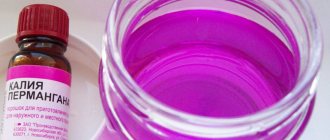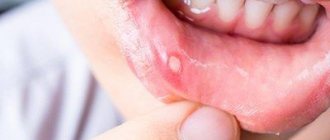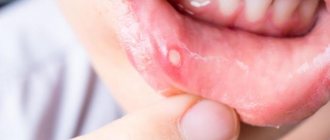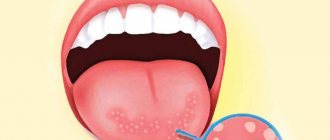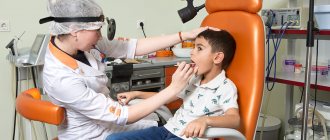Causes
Stomatitis is a disease that affects the mucous surfaces of the oral cavity. This is an acute inflammatory process of various etiologies, which is manifested by the appearance of yellowish or whitish pimples with liquid and ulcers. It can occur in children and adults, but children are much more likely to suffer from the disease.
The rash affects the inside of the cheeks, gums, and tongue. Their appearance causes discomfort, since ulcerative wounds itch, hurt, and there is a constant burning sensation in the mouth.
Young children have extremely delicate oral mucous membranes. The body’s insufficiently developed defense system is not able to quickly cope with infectious agents, so the natural reaction of the immune system to their entry into the body is inflammation. Common causes of the disease are:
- insufficient oral hygiene;
- chronic gastrointestinal diseases;
- mucosal injuries;
- burn;
- ingestion of pathogenic bacteria from hands or toys.
Important! Treatment of stomatitis in children is possible at home. However, in order to choose the right treatment regimen, you cannot do without consulting a specialist.
Kinds
Today, 8 types of stomatitis can be diagnosed:
- bacterial;
- aphthous - manifests itself when immunity decreases due to gastrointestinal diseases and anemia;
- herpetic – occurs due to the herpes virus;
- viral;
- angular;
- allergic – a reaction to an allergen entering the child’s body;
- traumatic - the cause may be an accidental bite of the lip with teeth or scratches on the gum;
- fungal – infection of the oral cavity by fungi of the genus Candida.
All types of stomatitis can occur in childhood. However, from birth to 3 years, children are especially susceptible to aphthous, candidal, herpetic and allergic types. During the period of active growth of baby teeth, traumatic stomatitis often appears, caused by rupture of the soft tissue of the gums.
Note! Stomatitis does not always occur on its own. Quite often, rashes in the mouth are a sign of other diseases, so before treatment it is necessary to carry out a series of diagnostic measures to discover the exact cause.
Symptoms
The classic clinical picture for diagnosing stomatitis includes the following symptoms:
- swelling of the mucous membrane;
- the appearance of a white or yellowish coating;
- bad breath;
- dryness or excessive salivation;
- enlarged lymph nodes and increased temperature.
Stomatitis in children has similar and different symptoms. Each type of disease has its own differences in manifestations.
With allergic stomatitis, minor ulcerative lesions appear on the palate, gums, cheeks, and lips. They pass as soon as the irritant can be identified and removed. With aphthous, even one spot with a diameter of up to 1 cm may appear in the mouth. Its outer part is covered with a film, the ulcer is yellow, and its edges are inflamed. If stomatitis is herpetic, then the mucous membrane is affected by numerous rashes that merge into one large wound. These are blisters with clear liquid and are extremely painful. Often the herpes virus causes a deterioration in the general condition of the child’s body, accompanied by body aches and high fever.
The most common type of stomatitis in a child’s mouth is candidiasis. Its common name is thrush. 9 out of 10 parents have encountered this phenomenon at least once. It is characterized by the appearance of a white cheesy coating on the tongue, gums, and cheeks of the baby. It is often observed after completing a course of antibacterial therapy or as a consequence of infection of the mother’s nipples by Candida fungus. Candidiasis can also be caused by poor hygiene.
On a note! Regardless of the type of stomatitis, its treatment should be comprehensive and begin immediately after the first signs of damage to the oral cavity are detected!
Treatment options
How to cure stomatitis in a child? It’s worth noting right away that you can’t prescribe medications to your baby yourself. Only the pediatrician makes a diagnosis and makes recommendations for therapy. Attempts to overcome the disease on your own can lead to a worsening of the little patient’s condition. To determine the causative agent of the inflammatory process, a scraping is made and a virological study is carried out.
For stomatitis in children, what treatment will be most effective? Only those therapeutic measures will help that will affect the disease comprehensively, eliminating both the cause and external manifestations.
Medicines
When an accurate diagnosis is established, dentists prescribe medications for the treatment of stomatitis in children. They are conventionally divided into symptomatic and special.
The purpose of the first is to eliminate the symptoms that accompany the disease. For this purpose the following is prescribed:
- vitamin complexes to strengthen the body;
- antiviral drugs that fight viruses;
- antipyretic and anti-inflammatory drugs;
- anesthetic gels;
- ointments and solutions for treating the oral cavity.
- need to drink plenty of fluids
- gentle diet (exclude sour, salty, spicy)
Candidal stomatitis is treated with special pharmaceuticals that contain substances that kill the fungus. Creams suitable for internal use are prescribed. If an allergic type is detected, the pediatrician will add antihistamine drops or tablets to the general list. If the rash is caused by the herpes virus, you cannot do without taking antiviral drugs, as well as local treatment of the mucous membranes with antiherpetic ointment.
Attention! The entire oral cavity needs to be treated, since pathogens are found everywhere on the mucous membrane. They are not visible to the naked eye, but if they remain in the mouth, they will continue to spread and the treatment will be delayed.
Folk remedies
Have you noticed stomatitis in a child and don’t know how to treat it? Drug therapy can be supplemented with the use of traditional medicine. Compositions prepared from natural ingredients are used to treat stomatitis in children over 2 years of age.
The following formulations are suitable for treating mouth ulcers.
Soda and salt
0.5 tsp each Dissolve the components in warm water. Rinse your mouth with the solution 3-4 times a day after meals. Baking soda relieves inflammation and disinfects well. The same composition, only diluted with water to a mushy consistency, can be used to clean off plaque from fungal stomatitis using a finger wrapped in gauze.
Honey and aloe
The leaf of the plant is ground to a puree, and the same amount of natural honey is added to it. Apply to affected areas three times a day.
Chamomile with honey
Dried flowers are brewed in the proportion of 1 tbsp. for 250 ml of boiling water. Add 2 tsp to the cooled broth. honey Rinse your mouth with warm liquid 2-3 times a day.
Rinses can be prepared from other ingredients:
- sage;
- rosehip;
- St. John's wort;
- oak bark;
- flaxseeds;
- yarrow;
- calendula;
- propolis tinctures.
Lotions of essential oils help a lot.
Important! Folk remedies can only be used after consulting a pediatrician!
How to prevent stomatitis
To reduce the risk of getting an infection in your mouth, you should:
- regularly wash toys, hands, pacifiers, bottles;
- carry out wet cleaning and ventilate the room where the baby spends his leisure time;
- strengthen the immune system: strengthen the child, give vitamins, maintain proper sleep and wakefulness;
- provide a balanced diet;
- fight the bad habit of biting nails or other objects (pencils, pens, rulers);
- Make an appointment with the dentist twice a year for a routine examination.
Any disease should be treated in a timely manner, otherwise negative consequences cannot be avoided. Carefully examine the child’s oral cavity at the first complaints. When stomatitis occurs in infants, the first symptoms include behavioral changes, crying, and refusal of the breast or bottle. Children aged 1 year and older will be able to independently point out to their parents the source of discomfort. Get treated promptly and be healthy!
Treatment of stomatitis and cheilitis in children
Among diseases of the red border of the lips and oral mucosa in children, the most common are aphthous stomatitis and cheilitis.
Stomatitis, in turn, is divided into acute, subacute and recurrent. The pathological process can be represented by erythematous, vesicular-erosive, ulcerative or necrotic forms. The etiological and pathogenetic causes of stomatitis are very different, including mechanical damage to the oral mucosa.
However, as some authors note, aphthous stomatitis, which has an infectious-allergic nature, is more common. Clinically, it is manifested by the appearance of a round (up to 1 cm in diameter) inflammatory element in the form of a spot with a bubble on the surface, which eventually opens and forms erosion with rounded outlines, very painful, grayish-white or yellowish-gray in color.
The erosion is surrounded by an inflammatory ring; it heals within 1-7 days, leaving no traces. When the infiltrate is located around the salivary gland, the aphtha is represented by an ulcer with infiltrated edges and bottom; it heals within 2 months, leaving behind scars. Relapses of the disease often occur in the spring and autumn. The severity of the disease can increase over time: the number of aphthae increases and the duration of their healing reaches 2-4 weeks, relapses become more frequent. In children, this process is often accompanied by gingivitis and periodontitis.
Cheilitis is more common in children suffering from atopic dermatitis. The process involves the red border of the lips and the skin of the perioral area - this lesion is called atopic cheilitis. The area of the corners of the mouth is most affected, but the process never affects the oral mucosa. Patients initially experience itching, erythema with clear boundaries and swelling of the red border of the lips. Crusts may appear at the site of scratching. The symptoms of acute inflammation quickly subside, giving way to lichenification of the lips. The surface of the red border of the lips peels off with small scales and is cut by thin radial grooves; the skin in the corners of the mouth remains infiltrated for a longer time, which leads to cracks.
Treatment of this pathology, especially in children, should be comprehensive; Particular attention should be paid to the sanitation of foci of chronic infection in the oral cavity. Local therapy should include analgesics, antiseptics and epithelializing agents. Since the effectiveness of conventional drugs used in the treatment of aphthous stomatitis and atopic cheilitis is not high enough, we tried to find a drug that increases the effectiveness of therapy and is approved for use in children. Tablet forms of metronidazole have long been used in the complex treatment of gastritis, gastric and duodenal ulcers in pediatric practice, as well as in the treatment of amoebic dysentery, to stimulate reparative processes. The effectiveness of these drugs is explained by the possibility of influencing Helicobacter pylori and the gastritis caused by it [1].
The effectiveness of metronidazole in the treatment of periodontal diseases has been reported by a large number of authors. The drug turned out to be effective in the treatment of diseases associated with anaerobic flora, protozoa and bacteria; in addition, normalization of obligate flora in the oral cavity was noted [2, 3]. Good tolerability of topical oral metronidazole in combination with systemic antibiotics has also been reported in many studies.
The composition of the Metrogil Dent gel includes metronidazole, which has the above properties, as well as the antiseptic chlorhexidine, effective against gram-negative and gram-positive flora, lipophilic viruses, yeast and dermatophytes [4]. This combination explains the high effectiveness of the gel in the treatment and prevention of infectious diseases of the oral cavity. And since one of the reasons for the occurrence and recurrence of aphthous stomatitis is infection and, in addition, the duration of cheilitis, as a rule, depends on the addition of a secondary infection, the choice of this drug in the treatment of these diseases is the most optimal.
The convenience of using the gel in children is also due to the fact that the auxiliary substances included in its composition are menthol and sodium saccharin, which give the gel a pleasant sweetish menthol taste, and therefore the application of the gel does not cause negative emotions in children.
We use Metrogyl denta gel in the treatment of aphthous stomatitis in children. We observed 19 children with recurrent aphthous stomatitis aged 5 to 16 years. The drug was prescribed 3 times a day for aphthae. After applying the gel, patients were not recommended to rinse their mouths or eat food for 30 minutes. The effect was observed on the second day and was expressed in a decrease in pain and inflammation. Epithelization was observed within 3-5 days. As a rule, the process occurred against the background of diseases of the gastrointestinal tract and oral cavity, most often it was biliary dyskinesia and gingivitis. Thanks to the administration of Metrogil Denta gel for 10 days, 1 time at night, on the gums in 11 children, there was no relapse of the disease for 6 months. In 5 patients, the drug was used for primary aphthous stomatitis against the background of skin pyoderma, the effect was observed on the 3-4th day.
For cheilitis, the drug was prescribed to 15 children aged 5 to 15 years.
The drug was applied to the areas of inflammation 2 times a day, epithelization of the cracks occurred on the 4-5th day, after which the drug was taken once a day in combination with ceralin for 2 weeks. This combination of drugs made it possible to quickly stop acute manifestations of cheilitis, reduce itching and infiltration in the corners of the mouth, which made it possible to avoid the reappearance of cracks.
All patients had good tolerability of the drug, no side effects were observed, and in children of the younger group, application of the drug did not cause any negative emotions.
Based on the above, we can conclude that the use of Metrogil denta gel in the treatment of aphthous stomatitis and atopic cheilitis in children allows you to quickly and effectively cope with the acute manifestations of this pathology, avoid frequent recurrences and the addition of a secondary infection. In this regard, the drug can be recommended for use in pediatric practice as a highly effective remedy for the treatment of stomatitis and cheilitis.
Literature
- Guide: diagnosis and treatment of internal diseases. Medicine, 1999, vol. 3, p. 88.
- Ainamo J., Lie T., Ellingsen BH et al. Clinical responses to subgigival application of metronidazol 25% gel compared to the effect of subgigival scaling in adult periodontitis // J. of Clinical Periodontology. 1992. 19P12/: 723-9.
- Pedrazzoli V., Killian M., Karring T. Comparative clinical and microbiological effect of topical subgigival application of metronidazol 25% dental gel and scaling in the treatment of adult periodontitis // J. of Clinical Periodontology. 1992. 19/9P12/: 715-9.
- Baby N., Al Jasser N. Subgingival irrigation effect of chlorhexidine or sunguinarine and gingivitis in orthodontic patients // J. of Clinical Pediatric Dentistry. 1996 Spring. 20 (3): 225-8.

